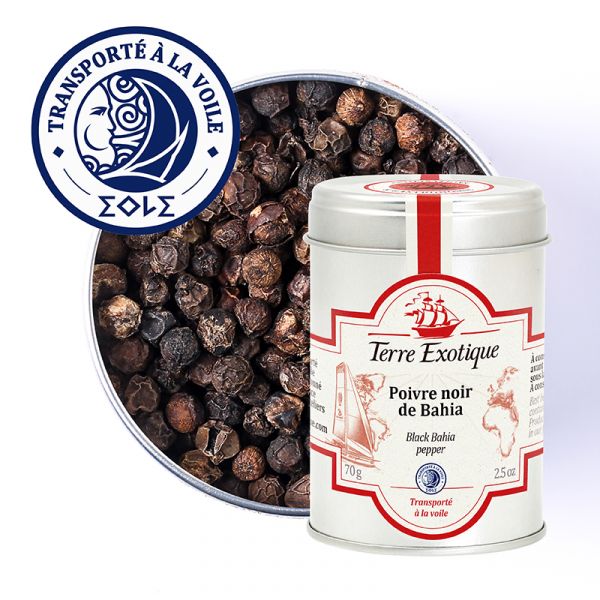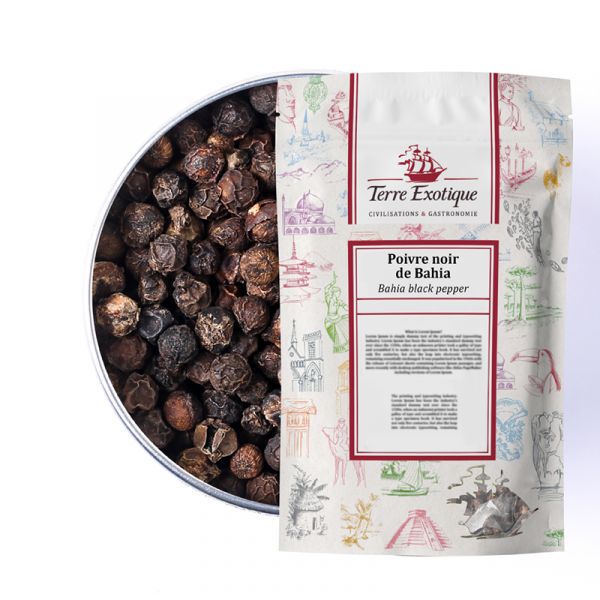





Where to use Bahia black pepper
Explore the woody flavours of this Brazilian pepper
Since we brought this Bahia black pepper back to France on our sailing ship, via our EOLE programme it has become one of our star peppers! These large peppercorns release powerful aromas of camphor with a hint of resin almost like our local pine trees. Sprinkle over meat or even on strawberries – what a distinctive pepper!How to get the best from your Bahia black pepper
Our recipe ideas for this Bahia black pepper:• Rib-eye steak: sprinkle a few pinches of roughly cracked Bahia black pepper over your rib-eye steak just before serving;
• Moqueca: add 1.5 teaspoons of ground Bahia black pepper to your fish marinade (check out the complete recipe below);
• Peppery strawberry salad: sprinkle 1 teaspoon of ground Bahia black pepper over your chopped strawberries;
• Lobster tail carpaccio with Bahia black pepper: infuse 2 teaspoons of Bahia black pepper in milk then add the lobster tails aand marinate overnight;
• Chocolate macarons with Bahia black pepper: infuse the Bahia black pepper in the chocolate ganache then filter;
• Bahia black pepper mayonnaise: add 1 teaspoon of Bahia black pepper to your mayonnaise before whipping.
Moqueca recipe
Ingredients1 kg white fish (cod for example);
500 g raw shrimps;
3 peppers;
2 limes;
2 onions;
2 cloves of garlic;
40 cl coconut milk;
1 bouquet coriander;
3 tablespoons olive oil;
½ teaspoon Terre Exotique Espelette chilli pepper;
a few pinches Terre Exotique Madagascar Fleur de sel;
1.5 teaspoons ground Terre Exotique Bahia black pepper.
Method
Mix the lime juice, garlic and salt and Bahia pepper in a bowl. Add the fish then leave to marinate in the fridge for 2 hours.
Chop the onions, peppers then fry in olive oil and cook for 10 minutes. Slice the tomatoes and add to the frying pan with the fish, Espelette chilli pepper and coconut milk.
Cover and leave to simmer for 15 minutes before adding the shrimps and cook for another 5 minutes. Serve with basmati rice and sprinkle with freshly chopped coriander.
The aromas of Bahia black pepper
After the initial herbaceous scent, Bahia black pepper releases woody flavours of aniseed with notes of plants and resin. A complex and distinctive pepperBrazilian pepper
Where does Bahia black pepper grow?
Bahia black pepper is a Piper nigrum creeper which uses trees as stakes to grow in the warm and tropical climate of Salvador de Bahia in Brazil. Bahia black pepper, also called Belem pepper or Brazilian black pepper, grows in an idyllic setting in the Centre-East of Brazil facing the ocean in sandy soils, where it is watered by a drip irrigation system ensuring it gets the perfect amount of water and nutrients. Bahia black pepper is harvested in the summer, then each grain is separated from the drupe and dried, sheltered from the rain. Bahia black pepper is a large grain pepper with a delicious aroma.The history of Bahia black pepper
The very first pepper plants were introduced to Brazil at the end of the 16th century. These pepper creepers were first planted in the gardens of Jesuit priests in Bahia and were looked after by a Franciscan monk from Goa in India. Nowadays, Brazil is the world’s third largest pepper producer, however Bahia black pepper only represents a tiny proportion of this production - 2% of Brazil’s total pepper production. This black pepper comes from a young agroforestry plantation near Porto Seguro, in Bahia, on a hill on the edge of the forest, facing the Atlantic. It was created by a French farmer who set up in Brazil more than 20 years ago and is farmed exclusively by the local community. This plantation produces black, white and red pepper in compliance with forest agroecology practices (no chemical input, no pesticides, dried naturally, sorted by hand, etc.). The pepper is harvested by hand at different stages of maturity depending on the type of pepper required. The quality of any pepper depends greatly on how it is picked. This pepper is a rare treasure as only a few thousand kilos are harvested each year. The peppercorns are then spread out to dry in the sun for several days and turned regularly so that they don’t start to ferment. Thanks to our Eole programme, as well as being delicious it is also sustainable, as it is transported from Brazil on our sailing ship! This is one of the best ways to bring together different civilisations and to set sail in search of the world’s amazing gastronomic treasures...| Allergen | Absence |
|---|---|
| Native country | BRESIL |
| Genus and botanical species | Piper nigrum |
| Ingredients | Bahia black pepper |
| Nutritional Info | VN Energie pour 100 g (energy for 100g) : 1239 kJ / 296 kcal VN Matière grasse (fat) : 2 g Dont acide gras saturés (of which saturated fat) : 1 g VN Glucides (carbohydrate) : 69 g Dont sucres (of which sugars) : 0.69 g VN Protéines (protein) : 10 g Vn Sel (salt) : 0.005 g |
| TRACES EVENTUELLES D'ALLERGÈNES | céleri, sésame, moutarde, fruits à coques. |
 Français
Français 





